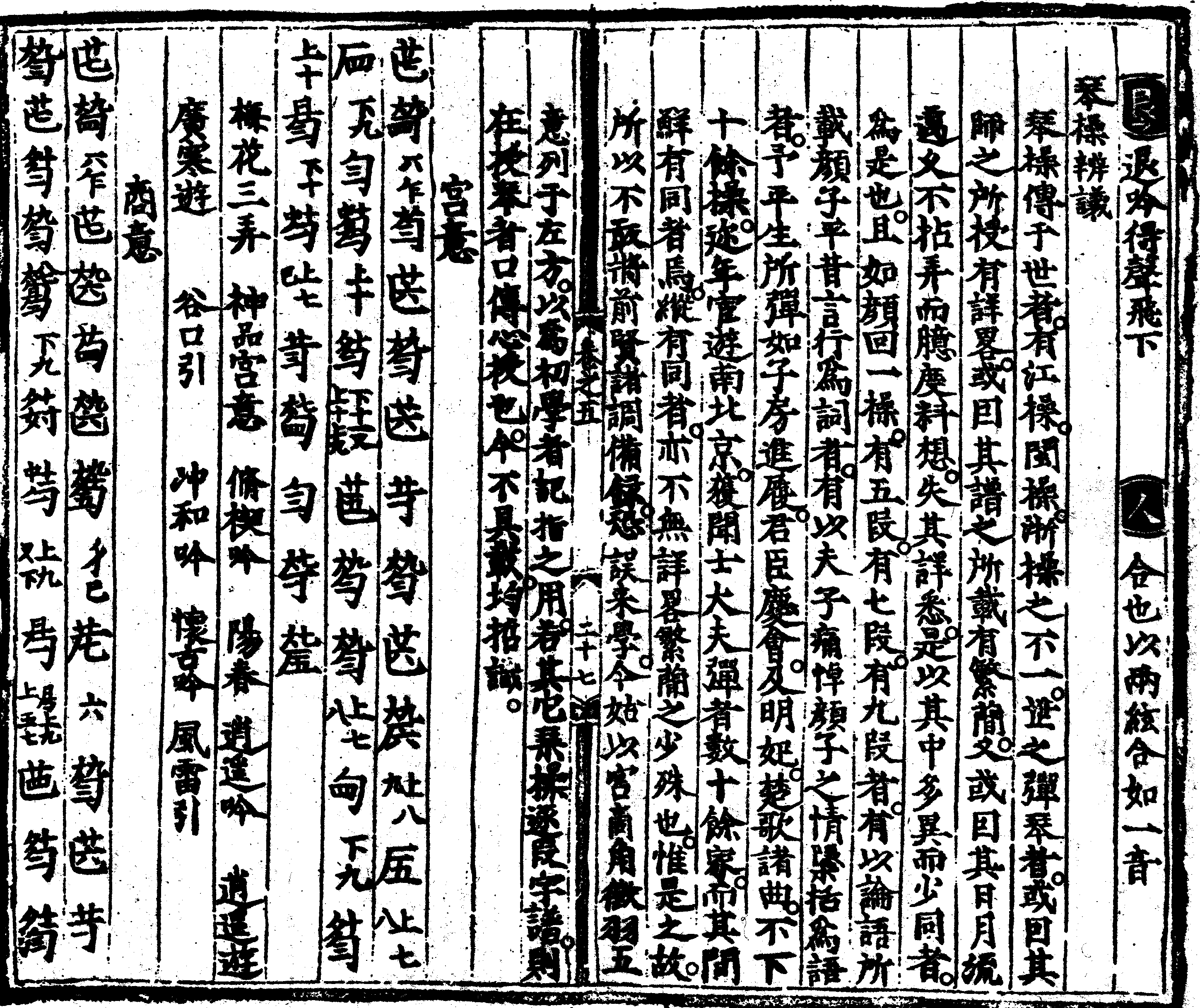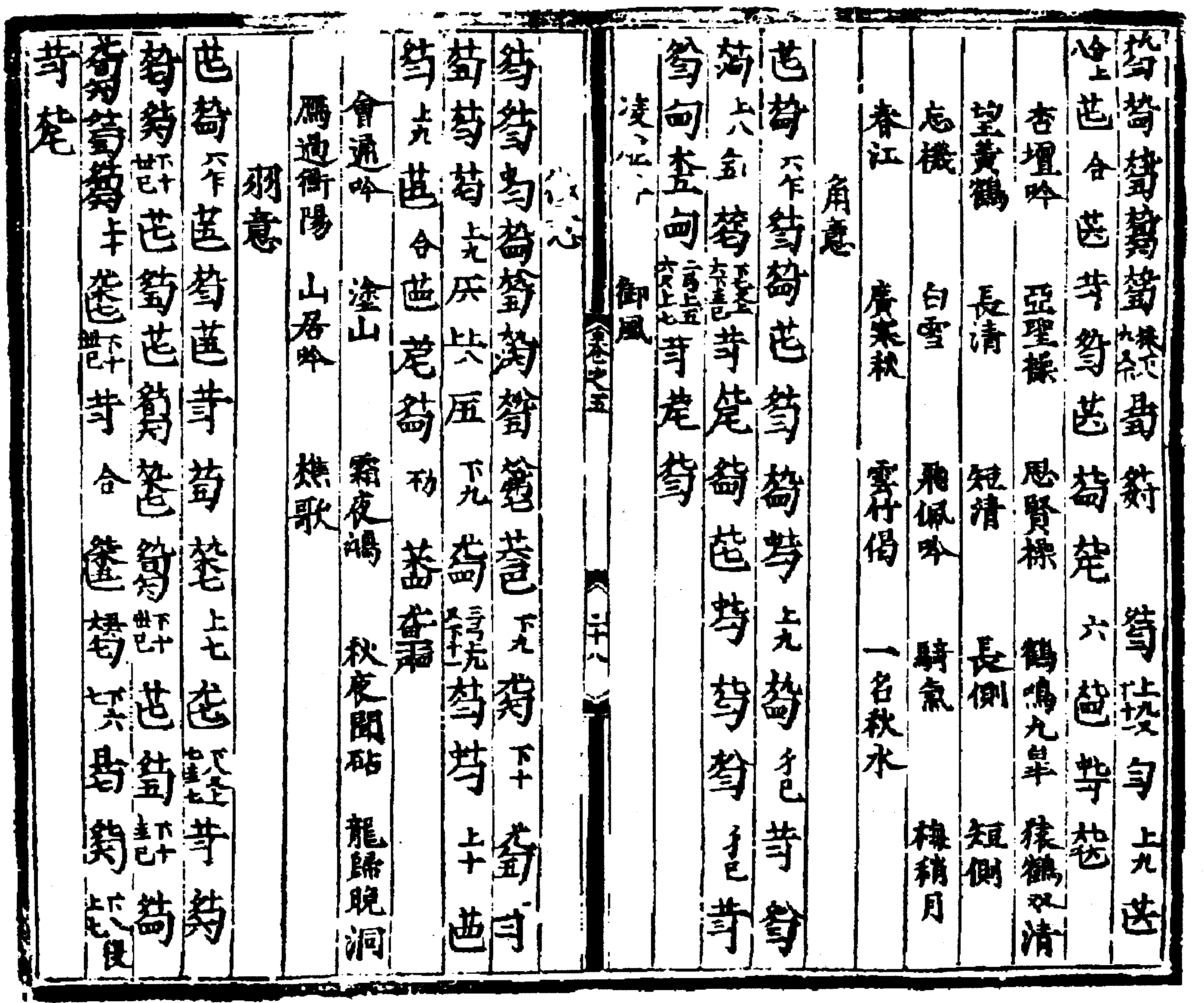|
T of C
Home |
My Work |
Hand- books |
Qin as Object |
Qin in Art |
Poetry / Song |
Hear, Watch |
Play Qin |
Analysis | History |
Ideo- logy |
Miscel- lanea |
More Info |
Personal | email me search me |
| Taiyin Daquanji ToC Folio 5-6 ToC / "Folio 6": ToC Parts: 1&2 / 3-8 / 9-20 / 21-24 / R-L hands / Preludes / Closing / Wusilan fingerings2 | 網站目錄 |
| Taiyin Daquanji 1 | 太音大全集 |
| Folio "6", Essay, Modal Preludes and Melody Names | 卷六:I/102a |
 Also: The related recordings & transcriptions
Also: The related recordings & transcriptions
The first column in the image at right has the final two items from the previous page. Then:
琴操辨議 Qin Cao Bian Yi 3 (Discerning the Significance of Qin Melodies), by Yuan Junzhe 4.
且如顏回》 一操,有五段(者),有七段(者),有九段者。有以《論語》所載顏子平昔言行為詞者, 有以夫子痛悼顏子之情緊括為語者。予平生所彈,如《子房進履》、 《君臣慶會》 及《明妃》、 《楚歌》諸曲,不下十餘操。迩年宦遊南北京,獲聞士大夫彈者數十餘家,而其間鮮有同者焉。縱有同者,亦不無詳畧緊簡之少殊也。
惟是之故,所以不敢將前賢諸調備錄,恐誤來學。今姑以宮、商、角、徵、羽五意列于左方, 以為初學者記指之用。若其它琴操遂段字譜,則在授琴者口傳心授也。 今不具載。
均哲識。
The qin melodies passed down through generations include Jiang melodies, Min (Fujian) melodies and Zhe (Zhejiang) melodies, each style different. This may be because what they learn from their teachers is different in detail and perspective, because the tablature they use varies in the amount of detail it provides, or because as days and months have passed they have not practiced regularly, leading to reliance on speculation and imagination. Consequently, there are more differences and fewer similarities.
For instance, the melody Yan Hui exists in versions with five, seven, or nine sections. Some versions take inspiration from the words and deeds of Yan Hui while others use the Analects to condense Confucius’ grief for Yan Hui into succinct phrases. In my lifetime, I have played pieces such as Zifang Presents the Shoes, The Celebration of Ruler and Minister, as well as Mingfei and Song of Chu, among others — no fewer than a dozen pieces. In recent years, during my official travels to the southern and northern capitals, I have heard dozens of scholars and officials playing, yet rarely have I encountered identical renditions. Even when they are playing from the same tablature, minor differences in detail and conciseness still exist.
For this reason, I do not dare to transcribe all the past masters’ melodies in full, lest I mislead future learners. At present, I merely list the five tones (modes) — gong, shang, jue, zhi, and yu — on the left, recording the fingerings for use by beginners. As for other actual qin melodies with their sectioning and tablature, these must be transmitted mouth to mouth and heart to heart by instructors. Hence, I do not include them in detail here.
(As can be seen below, other than the modal preludes there are only the titles of the related melodies, no tablature.)
Respectfully inscribed, (Yuan) Junzhe.
(Qin tablature in Taiyin Daquanji 5 [the lists below and my own transcriptions are both based on the Yuan volume text6]:
Five modal preludes7 [#s 1, 13, 32, 35 and 44 below]; my recordings and transcriptions are online afterwards.8)
- Gong Yi (tablature [compare 1425], then the following list of melodies9; I/102)
- Meihua Sannong (1425)
- Shenpin Gong Yi (1425)
- Xiuxi Yin (1525; compare Liu Shang and Jiu Kuang)
- Yang Chun (1425; see Bai Xue below)
- Xiaoyao Yin (1525)
- Xiaoyao You (1525)
- Guanghan You (1425)
- Gukou Yin (1525)
- Chonghe Yin (1525)
- Huai Gu Yin (1525)
- Feng Lei Yin (1539)
-
Shang Yi (tablature [compare 1425], then the following list of melodies10; I/102)
I/102b 
- Xing Tan Yin (1525)
- Yasheng Cao (1511)
- Si Xian Cao (>1505)
- He Ming Jiu Gao (1425)
- Yuan He Shuang Qing (1511)
- Wang Huang He (望黃鶴 14997.xxx Gazing at Yellow Crane [Pavilion?])
- Chang Qing (1425)
- Duan Qing (1425)
- Chang Ce (1525)
- Duan Ce (1525)
- Wang Ji (1425)
- Bai Xue (1425; see Yang Chun above)
- Fei Pei Yin (1590)
- Qi Qi (1525)
- Mei Shao Yue (1525)
- Chun Jiang (1539 and 1525)
- Guanghan Qiu (1425)
- Yun Zhu Ji (雲竹偈 Cloud Bamboo Verse; compare
Yun Zhu Ta)
"Yi Ming Qiu Shui" (一名秋水 "also called Qiu Shui"? Written here as though a separate title) - Jue Yi (tablature [compare 1425], then the following list of melodies11; I/102)
- Lingxu Yin (1425)
- Yu Feng (1425)
- Zhi Yi (tablature [compare 1425], then the following list of melodies12; I/102)
- Hui Tong Yin (會通吟, compare 會同引 in 1525)
- Tu Shan (1425)
- Shuang Ye Hong (1525)
- Qiu Ye Wen Zhen (秋夜聞砧 On an Autumn Evening Hearing the Stone: like Dao Yi?)
- Long Gui Wan Dong (1525)
- Yan Guo Hengyang (1539)
- Shan Ju Yin (1425)
- Qiao Ge (1425)
-
Yu Yi (tablature [I/102; compare 1425], then the following list of melodies13; I/103)
(The Yu mode pieces begin in the top image on the next page)
- He Wu Dongtian (1525)
- Zhi Zhao Fei (1425)
- Yushu Lin Feng (1525)
- Wu Ye Ti (1425)
- Pei Lan (1539)
- Huangzhong Yi (see 1425; no tablature, only the following list of melodies)
- Huangyun Qiusai (1425)
- Da Ya (1425)
- Yi Guan Shan (1525 has it as a prelude for Han Gong Qiu, also called Qiu Shan Yin)
- Qiuhu (presumably Qiuhu Xing, but could it be a misprint for Qiushan?: see previous entry)
- Zhaojun Yuan (1425)
- Qiliang Yi (see 1425; no tablature, only the following list of melodies)
- Chu Ge (1425)
- Shenpin Chushang Diao (1425)
- Zepan Yin (1425)
- Li Sao (1425)
- Shenpin Wuyi Yi14 (see 1425; no tablature, only the following list of melodies)
- Yong Qing Yin (永清吟 17461.142xxx [yongqing: clear for a distance; place name])
- Da Hujia (1425)
- Ruibin Yi (see 1425; no tablature, only the following list of melodies)
- Fan Canglang (1425)
- Shui Yun (1425)
- Guxian Yi (see 1425; no tablature, only the following list of melodies)
- Feiming Yin (1425)
- Qiu Hong (1425)
- Fugu Kaizhi (復古開指 see 1525 Fugu Yi: these use same tuning as Huangzhong and Wuyi, but only 5 strings)
- Lishan Yin (歷山吟 1525)
- Nanfeng Chang (not 1525 [standard tuning] but 1551)
Continue on next page
Footnotes (Shorthand references are explained on a
separate page)
1.Taiyin Daquanji
See comments with right hand technique explanations. The Taigu Yiyin in Qin Fu p. 102 is more clear.
(Return)
2.
Explanations by translator
See comments concerning the structure of the original text. This section continues what is in some versions of this handbook a section (see QQJC I/94 - 103) that is considered either as a continuation of Folio 5 or of Folio 6. From pp. 94-101 it has a section with no overall title but with 24 numbered entries on a variety of themes, including finger techniques and rules that should be followed.
(Return)
4.
袁均哲 Yuan Junzhe
(Return)
5.
The other example of modal preludes apparently published in the Song dynasty are those in qin section of Shilin Guangji.
(Return)
6.
Three of the four surviving editions (all but YJZTGYY) have here tablature for each of the five modes using standard tuning. Each prelude is followed by a list naming melodies in that mode. After this are the names of several modes and melodies using non-standard tuning. QFTGYY (see again editions) is copied exactly from the Yuan volume, but there are some significant differences in the tablature and melody lists between the Yuan volume and the Zhu volume. Comparing the two, the Yuan volume (QQJC, New Series, pp. 102d/3) seems to be more reliable than the Zhu volume (QQJC Original Series, pp. 67/8). The melody lists are almost the same (the Zhu volume omits one gong mode title and has Wuyi Yi instead of Shenpin Wuyi Yi), but there are tablature differences in each of the five preludes. The differences do not suggest that one volume was correcting the other, so it is most likely that both simply copied mistakes from a still earlier volume. None of the tablature mentions harmonics, but both the gong and shang modal preludes seem to end with a phrase in harmonics.
(Return)
7.
Transcriptions and recordings from Taiyin Daquanji
My work reconstructing the music in Taiyin Daquanji, leading up to the transcriptions and recordings, suggests that the tablature is less complete and has more mistakes than does the tablature for preludes in Shilin Guangji. This makes interpreting these five more problematic. For more on modes see Modality in early Ming Qin tablature.
(Return)
8.
Five Short Modal Preludes (調意 diao yi)
Compare diao yi with
kaizhi.
(Return)
9.
Gong Yi in Taiyin Daquanji
(I/102; my transcription and recording 聽我的錄音)
There are minor tablature differences between the Yuan and Zhu volumes. Other than the opening phrase, a number of passages resemble phrases in 1425 Shenpin Gong Yi, including the last four notes. These four notes should probably be played in harmonics, but this is not indicated. Comparing the melody lists, the Zhu volume is missing Xiaoyao Yin.
Compare also Gong Diao.
(Return)
10.
Shang Yi in Taiyin Daquanji
(I/102; my transcription and recording 聽我的錄音)
There are a few tablature differences between the Yuan and Zhu volumes, with the Yuan seeming more reliable. The prelude has some phrases found in the 1425 Shenpin Shang Yi, including several flatted mi, a characteristic commonly found in shang mode melodies surviving in early Ming tablature. The melody lists are identical. The last six notes should probably be played in harmonics, but this is not indicated. Compare also
Shang Diao.
(Return)
11.
Jue Yi in Taiyin Daquanji
(I/102; my transcription and recording 聽我的錄音)
There are a few tablature differences between the Yuan and Zhu volumes, with the Yuan seeming more reliable. The melody lists are identical. Jue mode preludes and melodies generally have gong as the primary tonal center, with the open 3rd string (called jue) being gong (see
Shenpin Jue Yi and
chart). But here the main note throughout is yu (the open 7th string is yu) right until the very last note, which is suddenly gong (gou the 3rd string with the ring finger in the 7th position). The effect is rather strange, though this is somewhat diminished if this last note is played in harmonics. Compare also Jue Diao.
(Return)
12.
Zhi Yi in Taiyin Daquanji
(I/102; my transcription and recording 聽我的錄音;
two alternate transcriptions)
There are a few tablature differences between the Yuan and Zhu volumes, with both having some obvious mistakes. This is the only one of the five preludes not to begin "tiao the open 7th string; gou the 4th string stopped in the 9th position; repeat". However, later zhi modal preludes do begin with that pattern, and the 1425 Shenpin Zhi Yi contains several phrases found also here in Zhi Yi, so I have added the opening passage to my own transcription. The tuning here seems to be treated as 5 6 1 2 3 5 6 instead of 1 2 4 5 6 1 2 (see
comment under Shenpin Zhi Yi). The two melody lists are identical. Compare also Zhi Diao.
(Return)
13.
Yu Yi in Taiyin Daquanji
(I/102; my transcription and recording 聽我的錄音)
There are several tablature differences between the Yuan and Zhu volumes, with the Zhu volume omitting an 11 note passage found in the Yuan volume. (The omitted passage begins with the same four clusters as the following phrase, suggesting the omission is a mistake). The modal characteristics are similar to those of later yu mode melodies, but the prelude here does not have any notable phrases found in the 1425 Shenpin Yu Yi. The two melody lists are identical. Compare also Yu Diao.
(Return)
14.
Shenpin Wuyi Yi
The Zhu volume has only "Wuyi Yi".
(Return)
Return to top or to the
Taiyin Daquanji ToC